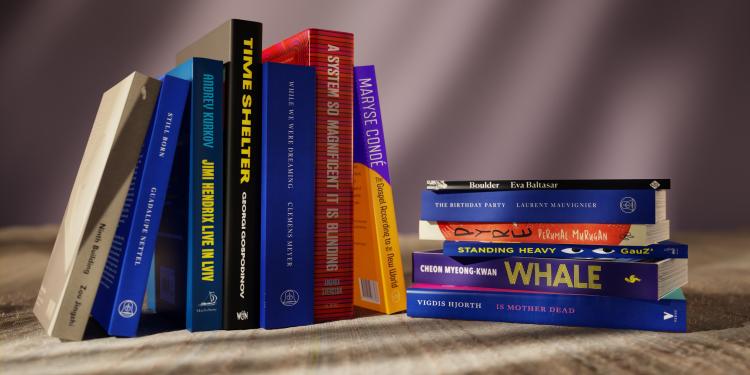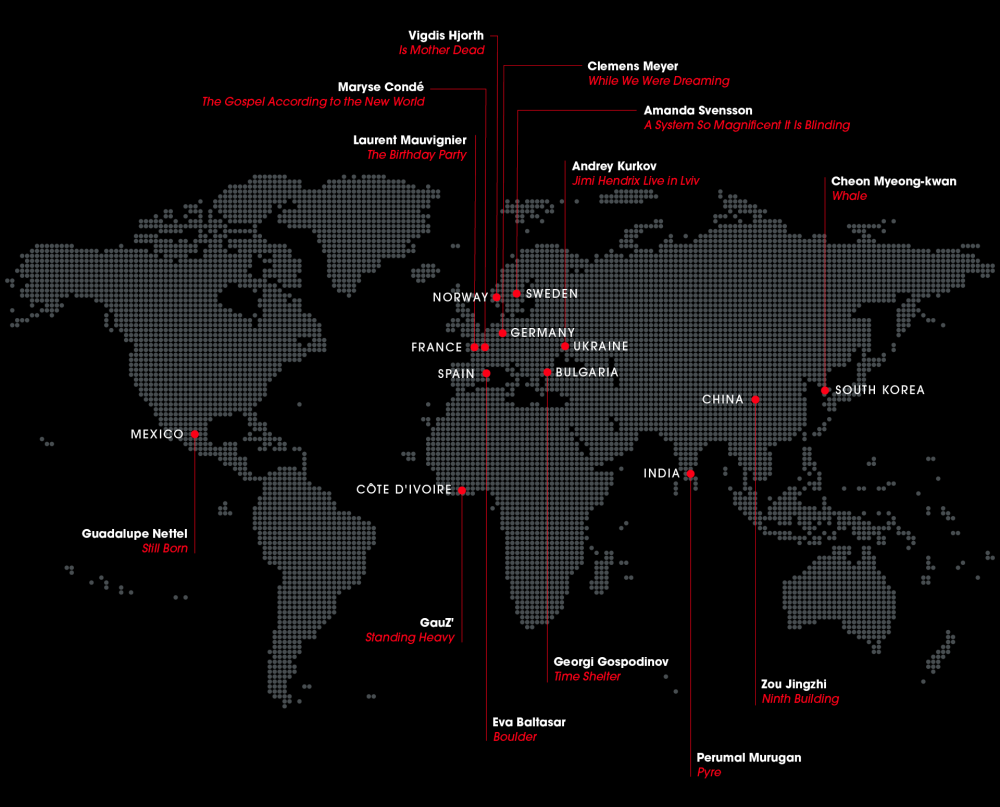
Reading list

Three original languages represented for the first time; a wife and husband author-translator duo; a writer who had once declared himself ‘dead’; poets, screenwriters and former security guards. Here are the key details and surprising facts about this year’s longlist
Spanning multiple continents, nations and languages, the International Booker Prize longlist is a chance to discover a huge range of literature in translation, from well-known names and under-the-radar authors.
Here are 13 essential facts to know about the books, authors and translators nominated for this year’s prize.
1.
In total, there are 11 languages represented on the longlist this year, and work originating in 12 countries. Alongside the more commonly translated languages, such as French and German, are three that have never appeared on the longlist before: Bulgarian (Georgi Gospodinov’s Time Shelter, translated by Angela Rodel), Catalan (Boulder by Eva Baltasar, translated by Julia Sanches), and Tamil (Pyre by Perumal Murugan, translated by Aniruddhan Vasudevan). Only around 20 books a year are translated from Catalan into English.
2.
There is a 54-year gap between the oldest and youngest authors on the list. Maryse Condé, nominated for The Gospel According to the New World translated by Richard Philcox, is the oldest person to ever make the International Booker Prize longlist, at the age of 89. Born in Guadeloupe as the youngest of eight siblings, Condé is described by our judges as the ‘the great voice of the Caribbean’. The youngest author on this year’s list is Amanda Svensson, aged 35, who is nominated for A System So Magnificent it is Blinding, translated by Nichola Smalley. The youngest translator on the longlist is Reuben Woolley, aged 24, who has translated Andrey Kurkov’s Jimi Hendrix Live in Lviv.
3.
In another first for Maryse Condé, she and her translator Richard Philcox are the first husband-and-wife team ever nominated for the prize. Condé, who has a degenerative neurological disorder that makes it difficult to see, dictated The Gospel According to the New World to Philcox, who then translated it into English.
4.
Two of the authors on the longlist have been nominated before. Maryse Condé was shortlisted for the International Booker Prize in 2015 when the award operated in its previous guise and recognised authors for a body of work.
German author Clemens Meyer was longlisted in 2017 for Bricks and Mortar, but is this year longlisted for his debut novel, While We Were Dreaming, which was published in German in 2006 but has only just been translated into English by Katy Derbyshire, who also translated Bricks and Mortar.
In addition to Derbyshire, three more of the translators on the list (Nichola Smalley, Jeremy Tiang and Frank Wynne) have been nominated before. Tiang and Wynne were also judges for the 2022 prize.
Maryse Condé
© P. Matsas Leemage- Hollandse Hoogte5.
Clemens Meyer’s While We Were Dreaming is not the only novel to have had a long gap between being published in their original language and being translated into English. Korean author Cheon Myeong-kwan’s Whale, translated by Chi-Young Kim, was first published in South Korea in 2003.
6.
Amanda Svensson’s translator Nichola Smalley will be doing double duty this year during the International Booker Prize. As well as being nominated herself, she’ll also be promoting Baltasar’s Boulder, which is published by And Other Stories, where Smalley works as a publicist.
7.
There are authors on this year’s list representing Africa, Asia and Latin America, yet the most-represented continent is Europe, with eight nominations for authors, covering Bulgaria (Gospodinov), Norway (Vigdis Hjorth for Is Mother Dead, translated by Charlotte Barslund), France (Condé, plus Laurent Mauvignier for The Birthday Party, translated by Daniel Levin Becker), Germany (Meyer), Spain (Baltasar), Ukraine (Andrey Kurkov for Jimi Hendrix Live in Lviv, translated by Reuben Woolley) and Sweden (Svensson).
8.
French is the most-represented language, with three of the longlisted novels written originally in French. However, each of the three authors – Condé, Mauvignier and GauZ’, who is Ivorian – bring something different. Condé was born in Guadeloupe and was also professor emerita of French at Columbia University in New York; Mauvignier was born and brought up in France; and GauZ’ grew up in Côte d’Ivoire.
9.
Two of the authors share a former career: both Clemens Meyer and GauZ’ (real name Patrick Armand-Gbaka Brede) worked as security guards. Meyer was also a forklift truck driver.
Amanda Svensson
© Johan Hillebjörk10.
A number of authors’ work extends beyond writing long-form fiction. GauZ’ is a photographer and the editor-in-chief of the Ivorian satirical economic newspaper News & co. Svensson is herself a translator; she is the Swedish translator for the Booker Prize-nominated Ali Smith. Myeong-kwan is also a film director. Gospodinov, Wynne and Baltasar are also poets.
11.
Svensson and GauZ’ are two of three authors appearing for their first works translated into English. The third is Chinese playwright Zou Jingzhi, nominated for Ninth Building, translated by Jeremy Tiang.
12.
Ukrainian writer Andrey Kurkov has spent his career writing fiction in Russian (he writes non-fiction in Ukrainian as well as Russian), the language of his parents and of about a third of Ukrainians. But the author, arguably Ukraine’s most famous living writer, has said he will not be writing any more books in Russian, following Russia’s invasion of Ukraine. His most recent book is 2022’s non-fiction title, Diary of an Invasion, a collection of his writings and broadcasts from Kyiv.
13.
One author – Perumal Murugan – appears on the list despite having once declared his ‘death’ as a writer. Murugan faced vicious protests against his novel One Part Woman by Hindu and caste-based groups, and in 2015 announced that he planned to stop writing. He also asked publishers to withdraw all works of his fiction from sale. He returned from his self-imposed silence in 2017 with a novel called Poonachi: Or The Story of a Black Goat.
Perumal Murugan
© Srinivasan Natarajan


